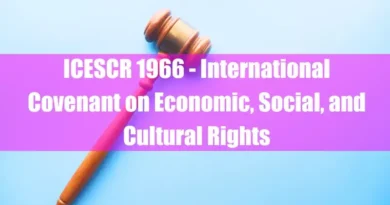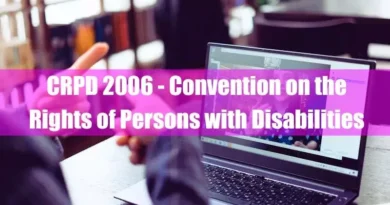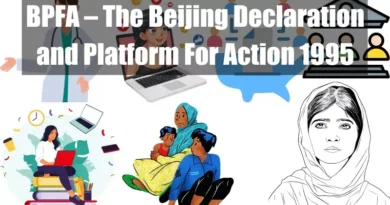Here is an informational table summarizing the key takeaways from the article on the “Declaration on the Elimination of Violence against Women (DEVAW) 1993”:
| Section | Key Takeaways |
|---|---|
| Introduction | DEVAW 1993 is a pivotal document in women’s rights, not legally binding but influential in shaping international and domestic laws on violence against women (VAW). It defines VAW, reaffirms women’s rights, and outlines state obligations. |
| Historical Context of DEVAW (1948-1993) | DEVAW builds on previous human rights frameworks: UDHR (1948), CEDAW (1979), and the Vienna Declaration (1993). The 1980s saw growing global recognition of VAW as a critical issue, setting the stage for DEVAW’s development. |
| Defining Violence Against Women (Articles 1 & 2) | DEVAW provides a comprehensive definition of VAW, including physical, sexual, and psychological harm. It acknowledges violence in both public and private spheres and lists examples like intimate partner violence, sexual harassment, and trafficking. |
| The Rights of Women Under DEVAW (Article 3) | DEVAW reaffirms core human rights principles (equality, security, liberty) and highlights specific rights (life, health, security, justice). It emphasizes that VAW is a violation of human rights and calls for the elimination of gender-based discrimination. |
| State Obligations Under DEVAW (Article 4) | States are responsible for preventing VAW (education, public awareness), protecting victims (legislation, shelters), punishing offenders, and ensuring access to justice for victims. They must also engage in research, data collection, and international cooperation. |
| Implementation and Monitoring of DEVAW (Articles 5 & 6) | States must develop national strategies with clear goals and involve civil society in implementation. Regular reporting to the UN and monitoring progress are essential. Civil society organizations and national machinery play crucial roles in these processes. |
Let’s discuss in detail:
I. Introduction
The Declaration on the Elimination of Violence against Women (DEVAW), adopted by the United Nations General Assembly in 1993, is a landmark document in the fight for women’s rights. It’s not a legally binding treaty, but it has been highly influential in shaping international human rights law and domestic legislation related to violence against women.
Here are some key aspects of DEVAW 1993:
- Definition of Violence Against Women: DEVAW provides a widely used definition of violence against women (VAW). It defines VAW as any act of gender-based violence that results in or is likely to result in, physical, sexual, or psychological harm or suffering to women, including threats of such acts, coercion, or arbitrary deprivation of liberty. It encompasses violence occurring in public and private life.
- Women’s Rights: DEVAW emphasizes that violence against women is a violation of their human rights. It reaffirms women’s right to live a life free from violence and discrimination. This includes rights like equality, security, liberty, health, and justice.
- State Obligations: While not a binding treaty, DEVAW outlines expectations for what states should do to address VAW. This includes enacting laws to criminalize VAW, providing support services for victims, preventing violence through education and awareness campaigns, and collecting data on the prevalence of VAW.
- Implementation and Monitoring: DEVAW recognizes the importance of putting its principles into action. It encourages states to develop national plans of action and to submit reports to the UN on their progress in eliminating VAW. The Declaration also emphasizes the role of civil society organizations in monitoring and advocating for change.
Overall, DEVAW 1993 is a powerful tool for promoting gender equality and eliminating violence against women. It has played a crucial role in raising awareness, shaping international norms, and driving national action to create a safer world for women.
II. Historical Context of DEVAW: Building on Existing Frameworks (1948-1993)
The Declaration on the Elimination of Violence Against Women (DEVAW) in 1993 wasn’t born in a vacuum. It emerged from a rich history of human rights advancements, particularly those focused on women’s rights. Here’s a closer look at the key documents and events that paved the way for DEVAW:
A. 1948: Universal Declaration of Human Rights (UDHR):
This landmark document, adopted by the United Nations General Assembly, established the foundation for all subsequent human rights instruments. It enshrined principles of equality, security, and liberty for all, laying the groundwork for including women’s rights in future discussions.
B. 1979: Convention on the Elimination of All Forms of Discrimination Against Women (CEDAW):
This international treaty specifically addressed gender discrimination. While not explicitly mentioning violence against women, CEDAW laid the groundwork by recognizing discrimination based on sex as a violation of human rights. Notably, it included provisions on harmful traditional practices that could be considered forms of violence against women.
C. 1980s: Growing Recognition of Violence Against Women:
Throughout the 1980s, violence against women gained increasing recognition as a global issue. Feminist movements and grassroots organizations across the world started raising awareness about domestic violence, sexual assault, and other forms of violence women faced. These movements played a crucial role in pushing for international action.
D. 1993: Vienna Declaration and Programme of Action (VDPA):
This document, adopted at the World Conference on Human Rights in Vienna, marked a significant turning point. For the first time, an international document explicitly condemned violence against women. The VDPA called for states to take concrete measures to prevent and address violence against women, including enacting legislation, providing support services for victims, and prosecuting perpetrators.
Building on these existing frameworks, DEVAW (1993) further elaborated on the issue of violence against women. It provided a clear definition, established the rights of women to live free from violence, and outlined the obligations of states to take comprehensive action.
DEVAW drew upon the human rights principles enshrined in the UDHR and the specific focus on gender equality in CEDAW. It also built upon the growing momentum created by the VDPA’s explicit condemnation of violence against women.
This historical context helps us understand how DEVAW became such a powerful tool in the fight to eliminate violence against women.
According to General Assembly resolution 48/104 Declaration on the Elimination of Violence against Women:
Acknowledging the pressing necessity for the universal extension of rights and principles pertaining to equality, security, liberty, integrity, and dignity to women,
Observing that these rights and principles are codified in international instruments, notably the Universal Declaration of Human Rights, the International Covenant on Civil and Political Rights, the International Covenant on Economic, Social and Cultural Rights, the Convention on the Elimination of All Forms of Discrimination against Women, and the Convention against Torture and Other Cruel, Inhuman or Degrading Treatment or Punishment,
Recognizing that the effective implementation of the Convention on the Elimination of All Forms of Discrimination against Women would significantly contribute to the eradication of violence against women and that the Declaration on the Elimination of Violence against Women, outlined herein, will reinforce and complement this endeavor,
Expressing concern that violence against women hinders the attainment of equality, development, and peace, as affirmed in the Nairobi Forward-looking Strategies for the Advancement of Women, which recommended a series of measures to combat violence against women, and impedes the full realization of the Convention on the Elimination of All Forms of Discrimination against Women,
Affirming that violence against women violates the rights and fundamental freedoms of women, undermining their ability to enjoy those rights and freedoms, and expressing apprehension regarding the longstanding failure to safeguard and promote these rights and freedoms in cases of violence against women,
Recognizing that violence against women stems from historically unequal power dynamics between men and women, resulting in the domination over and discrimination against women by men, hindering the full advancement of women, and acknowledging that violence against women is a pivotal social mechanism reinforcing women’s subordinate status compared to men,
Expressing concern that certain groups of women, including but not limited to women belonging to minority groups, indigenous women, refugee women, migrant women, women residing in rural or remote areas, impoverished women, women in institutional settings or detention, female children, women with disabilities, elderly women, and women in situations of armed conflict, are particularly susceptible to violence,
Recalling the finding in paragraph 23 of the annex to Economic and Social Council resolution 1990/15 of 24 May 1990, which emphasized the pervasive nature of violence against women within families and societies cutting across lines of income, class, and culture, and emphasized the urgent need for effective measures to eliminate its prevalence,
Also recalling Economic and Social Council resolution 1991/18 of 30 May 1991, wherein the Council recommended the development of an international instrument framework explicitly addressing the issue of violence against women,
Commending the role of women’s movements in increasingly highlighting the nature, severity, and scope of the issue of violence against women,
Expressing alarm that women’s opportunities to attain legal, social, political, and economic equality within society are hindered, among other factors, by persistent and widespread violence,
Convinced that, in light of the considerations above, there exists a need for a clear and comprehensive definition of violence against women, a definitive statement of the rights necessary to ensure the eradication of violence against women in all its forms, a commitment by States to fulfill their responsibilities in this regard, and a commitment by the international community as a whole to the elimination of violence against women,
Hereby proclaims the following Declaration on the Elimination of Violence against Women and urges that every endeavor be made to ensure its widespread recognition and respect.
III. Defining Violence Against Women (Articles 1 & 2)
DEVAW’s strength lies in its clear and comprehensive definition of violence against women. Articles 1 and 2 lay the foundation for understanding the issue and its various forms.
A. Physical, Sexual, and Psychological Harm
The definition encompasses a broad range of acts that inflict physical, sexual, or psychological harm on women. This includes physical assaults, rape, sexual harassment, trafficking, forced marriage, and other harmful traditional practices. Psychological violence can encompass threats, intimidation, emotional abuse, and isolation. Importantly, DEVAW recognizes that violence can occur within the family or the general community, both by state and non-state actors.
B. Public and Private Sphere (Violence in the Family, Community, and State)
Traditionally, violence against women was considered a private matter. DEVAW shattered this notion by acknowledging that violence can occur anywhere – in the home, workplace, on the street, or even perpetrated by state actors.
- Violence in the Family: This includes intimate partner violence, marital rape, and violence against female family members.
- Violence in the Community: Women can face sexual harassment, assault, stalking, and other forms of violence in public spaces or by strangers.
- Violence by the State: This includes torture, arbitrary detention, and war crimes against women.
By recognizing violence across these spheres, DEVAW highlights the need for comprehensive approaches that address the issue in all its forms.
C. Examples of Violence Against Women (Physical Assault, Intimate Partner Violence, Sexual Harassment, Trafficking, etc.)
Here are some specific examples of violence against women covered by DEVAW:
- Physical assault: This includes hitting, kicking, shoving, and any other act that inflicts bodily harm.
- Intimate partner violence: This refers to violence perpetrated by a current or former romantic partner, including physical, sexual, and emotional abuse.
- Sexual harassment: This can be unwelcome sexual advances, requests for sexual favors, and other forms of verbal or physical conduct of a sexual nature.
- Trafficking: This involves the recruitment, transportation, or harboring of people for forced labor, sexual exploitation, or slavery. Women and girls are disproportionately targeted for trafficking.
- Forced marriage: This involves marrying someone without their free and full consent.
- Harmful traditional practices: Examples include female genital mutilation (FGM) and honor killings.
This list is not exhaustive, and DEVAW recognizes the evolving nature of violence against women.
D. Distinguishing DEVAW’s Definition from Other Forms of Violence
It’s important to distinguish violence against women from other forms of violence. While violence can affect anyone, DEVAW specifically focuses on violence directed at women based on gender. This violence can be fueled by harmful stereotypes, power imbalances, and a sense of entitlement over women’s bodies and lives.
IV. The Rights of Women Under DEVAW (Article 3)
DEVAW goes beyond defining violence. Article 3 is crucial, as it reaffirms that women have the fundamental right to live a life free from violence. This article establishes a clear link between violence against women and the violation of their human rights.
A. Reaffirmation of Human Rights Principles (Equality, Security, Liberty, etc.)
The article begins by reaffirming core human rights principles enshrined in other international instruments. These principles include:
- Equality: Women have the right to equal treatment and protection under the law.
- Security: Women have the right to live free from fear of violence and to be secure in their person.
- Liberty: Women can make choices about their lives without coercion or threat.
- Non-discrimination: Women should not be subjected to discrimination based on their gender, including violence that stems from such discrimination.
B. Specific Rights Highlighted by DEVAW (Right to Life, Health, Security, Justice, etc.)
Building on these foundational principles, DEVAW emphasizes specific rights women are entitled to:
- Right to Life: Violence against women can threaten their lives. DEVAW underscores a person’s right to life and security.
- Right to Health: Violence can have devastating physical and mental health consequences. The Declaration acknowledges the right to the highest attainable standard of health, including mental health.
- Right to Security: Women have the right to be free from fear of violence in their homes, communities, and workplaces.
- Right to Justice: Victims of violence have the right to access justice and effective remedies, including protection from further violence and prosecution of perpetrators.
C. Connection Between Violence Against Women and Human Rights Violations
DEVAW establishes a clear connection between violence against women and the violation of their human rights. When a woman experiences violence, her right to life, security, health, and other fundamental rights are compromised. By addressing violence against women, we are upholding their human rights and promoting gender equality.
D. The Right to Live Free from All Forms of Discrimination
Finally, Article 3 emphasizes the right to live free from all forms of discrimination, including discrimination that leads to violence. Gender-based stereotypes and discriminatory practices can create environments where violence against women is tolerated or even condoned.
DEVAW calls for the elimination of all forms of discrimination that contribute to violence against women.
V. State Obligations Under DEVAW (Article 4)
DEVAW doesn’t just define the problem and women’s rights; it holds states accountable for taking action. Article 4 outline a comprehensive framework for state obligations to prevent, address, and ultimately eliminate violence against women. Let’s delve into these key obligations:
A. Prevention of Violence Against Women (Education, Public Awareness Campaigns)
Prevention is a cornerstone of DEVAW. States are obligated to take proactive measures to prevent violence against women from happening in the first place. This includes:
- Education: States should develop educational programs that promote gender equality, challenge harmful stereotypes, and raise awareness about violence against women.
- Public Awareness Campaigns: Implementing public awareness campaigns can help shift social norms and attitudes that condone violence against women.
- Research: Funding research on the causes and consequences of violence against women is crucial for developing effective prevention strategies.
B. Protection Measures (Legislation, Shelters, Support Services)
Once violence occurs, states have a responsibility to protect women and ensure their safety. This involves:
- Legislation: States must enact comprehensive laws that criminalize all forms of violence against women and provide for appropriate penalties.
- Shelters and Support Services: Safe havens and support services are essential for women fleeing violence. This includes shelters, hotlines, counseling, and legal aid.
- Order of Protection Systems: States should establish effective legal mechanisms to protect victims from further harassment or abuse by perpetrators.
C. Punishment of Offenders (Criminal Justice System Reforms)
Addressing violence against women requires holding perpetrators accountable. States’ obligations include:
- Investigation and Prosecution: Prompt, thorough, and impartial investigations of violence against women are crucial. States need to ensure perpetrators are prosecuted and face appropriate punishment.
- Judicial Training: Judges, prosecutors, and law enforcement officials need training to handle cases of violence against women effectively.
- Victim-Centered Approaches: The criminal justice system should prioritize the safety and well-being of victims while ensuring due process for the accused.
D. Civil Remedies and Access to Justice for Victims (Legal Aid, Compensation)
Beyond criminal justice, DEVAW emphasizes civil remedies and victims’ access to justice. This includes:
- Legal Aid: Victims should have access to legal aid to pursue civil remedies, such as seeking compensation for damages incurred due to violence.
- Compensation: States may consider establishing mechanisms for compensating victims for the physical, psychological, and economic harm suffered.
E. Research and Data Collection on Violence Against Women
Effective strategies require accurate data. States are obligated to:
- Collect Data: Collect and analyze data on the prevalence, nature, and consequences of violence against women.
- Research: Encourage research on violence against women to understand the root causes and identify effective interventions.
- Share Information: States should share data and research findings with civil society organizations.
F. International Cooperation and Assistance
DEVAW recognizes the global nature of violence against women and the need for international cooperation. This includes:
- Bilateral and Multilateral Cooperation: States should collaborate to share best practices, provide technical assistance, and offer financial support to address violence against women.
- International Organizations: Collaboration with international organizations like the UN is crucial for developing global strategies and monitoring progress.
- NGO Engagement: States should actively engage with NGOs working on violence against women’s issues to leverage expertise and resources.
By fulfilling these obligations, states can create a safer environment for women and contribute to the goal of eliminating violence against women.
VI. Implementation and Monitoring of DEVAW (Articles 5 & 6)
DEVAW goes beyond simply outlining state obligations. It emphasizes the importance of effective implementation and monitoring mechanisms to ensure progress towards eliminating violence against women. Articles 5-6 address these crucial aspects.
A. National Level Implementation Strategies and Plans
States are obligated to develop national-level implementation strategies and plans. These plans should:
- Set Clear Objectives and Targets: Define specific goals and measurable targets for reducing violence against women.
- Identify Priority Areas: Focus on areas with the highest prevalence of violence or where specific groups of women are most vulnerable.
- Allocate Resources: Dedicate adequate financial and human resources for implementing the plan.
- Involve Stakeholders: Engage with civil society organizations, women’s groups, and other relevant stakeholders in developing and implementing the plan.
B. Reporting Requirements to the UN
States must submit periodic reports on their progress in eliminating discrimination against women to the UN Committee on the Elimination of Discrimination against Women (CEDAW)
The DEVAW itself does not specifically mandate reporting to CEDAW. Instead, DEVAW encourages reporting and monitoring through various mechanisms.
These reports should:
- Highlight Measures Taken: Outline the laws, policies, and programs implemented to address violence against women.
- Challenges Faced: Identify any obstacles encountered in implementing DEVAW.
- Progress Made: Report on the measurable achievements in reducing violence against women.
C. Role of National Machinery and Civil Society Organizations
DEVAW recognizes the crucial role of national machinery and civil society organizations (CSOs) in implementing the Declaration.
- National Machinery: This refers to government bodies or focal points responsible for coordinating efforts on violence against women. They play a key role in developing and implementing national plans and monitoring progress.
- Civil Society Organizations: NGOs, women’s rights groups, and other CSOs bring expertise, resources, and on-the-ground experience to address violence against women. States should actively engage with CSOs and create an enabling environment for their work.
D. Monitoring Mechanisms and Evaluation of Progress
Regular monitoring and evaluation are essential for assessing progress and identifying areas where additional efforts are needed. This can involve:
- Data Collection and Analysis: Regularly collect and analyze data on violence against women to track trends and measure impact.
- Independent Monitoring Bodies: Consider establishing independent bodies to monitor the implementation of DEVAW and hold states accountable.
- Stakeholder Participation: Involve civil society and women’s organizations in monitoring efforts to ensure diverse perspectives are considered.
States can establish robust implementation and monitoring mechanisms to ensure that DEVAW’s principles translate into tangible results for women’s safety and well-being.









